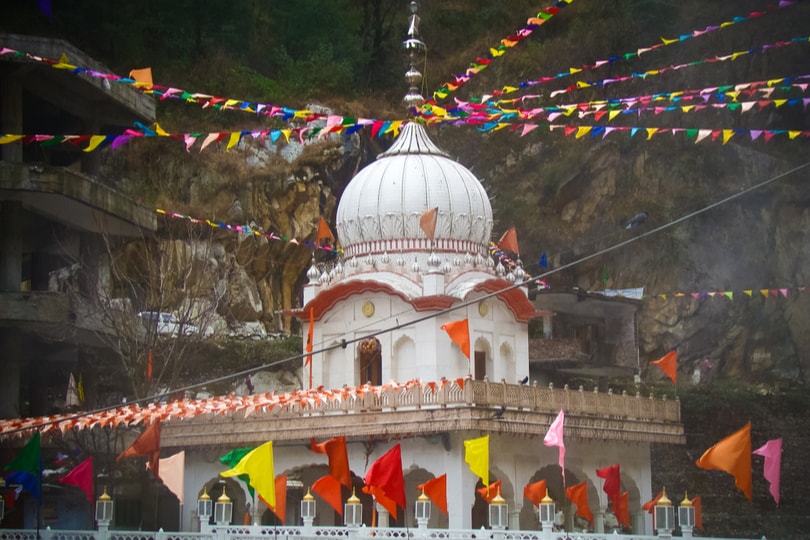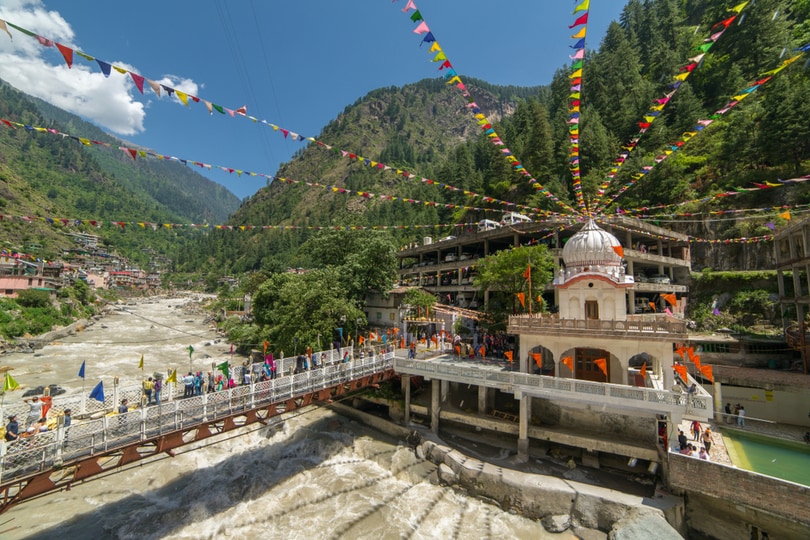

Situated deep within the Parvati Valley of the famous hill district of Kullu in Himachal Pradesh, the Manikaran Sahib is one of the prominent holy spots in India. Manikaran is located at an impressive altitude of 1760 m. Because of its proximity to the nearby Manali valley, it receives thousands of pilgrims and tourists, particularly in the summer months.
Manikaran Sahib is a vital pilgrimage spot for both Hindus and Sikhs. This place has significance in some of the earliest Hindu scriptures that highlight how Manu, the first human on earth, created life and saved this place from a flood. Several mythological tales around the region also document Hindu deities like Shiva, Parvati, and Vishnu.
The Sikh religious beliefs surrounding the place have the same richness as their Hindu counterparts.


If you are in Manikaran, you must spend some time learning about the origin and history of the Manikaran Sahib Gurudwara. Different tales narrated in Sikh scriptures recount plenty about the place’s history. While here, you can witness those stories come to life right in front of your eyes.
Guru Nanak is known to be an extensive traveller throughout his lifetime. He visited not only different parts of India but also other parts of Asia. Hagiographic accounts of the Sikh Guru demonstrate that all of his travels were well classified according to their purpose. His four missionary travels are called Udasis. During the third Udasi, Guru Nanak frequented the small village of Manikaran with one of his choicest disciples, Bhai Mardana. Back in that year of 1574, the idea of a community kitchen was still being popularized by him. Once the Guru and his disciple reached the place, they found themselves starving. Bhai Mardana asked the villagers to donate some raw grains and vegetables, such that he and his master could be sated. The villagers were generous enough to give flour and some other grains. However, the raw food had to be cooked, but lighting a fire seemed extremely challenging in a cold valley with limited resources. This dilemma was countered by the great Guru when he instructed his disciples to lift a mysterious stone from its spot. As soon as Bhai Mardana lifted the stone, hot water sprung from beneath it. This boiling water provided enough heat to cook food. However, the rice and the rotis kept sinking in the water, making it difficult for Mardana to cook anything. When Guru Nanak observed the same, he asked his disciples to chant, “I am going to donate my life in the name of God.” As soon as he said this, the drowned items floated back up.
This incident prompted Guru Nanak to declare one of his most cherished teachings – anything devoted to God will never drown. This miracle prompted devotees to worship that very spot and build a Gurudwara there to commemorate the Guru’s life and teachings. The vast white Gurdwara stands at that exact spot where Guru Nanak and Bhai Maradana cooked langar. Its beautiful complex continues to enchant visitors. It gives everyone a calm surrounding to meditate and synchronize their energy for the betterment of their lives. Every day at the Gurudwara, the Gurbani path is recited along with several other essential verses from the Guru Granth Sahib. Langar, a charitable community dining program run by gurudwaras all around the world, is also served here. Kadhas, an Indian soup made from herbs, is served to every devotee that visits here. This soup has medicinal properties and cures many lung and throat diseases.
The highly revered Manikaran gurudwara is mentioned in the Twelfth Khalsa, written by Giani Gian Sikh. A tunnel-like corridor inside the Gurudwara leads to a room called the garam Kothi. This is where the therapeutic hot spring exists. As a tourist, you might find the heat inside this room unbearable, but once you get accustomed to it, you will feel relieved.
The hot boiling spring in and around this Gurudwara is of great use both to locals and tourists. These hot springs are known to contain traces of metals such as Sulphur and Uranium, which have healing properties. Pilgrims take a dip into these hot springs a get a respite from the chilling cold that grips the Manikaran Valley. As a tourist, you can try a fun experiment to test the usefulness of the hot spring waters. Buy a muslin potli of rice from the nearby markets and dip it in the spring. You will watch the rice being cooked right in front of your eyes. This property of the spring is utilized by the Gurudwara management to cook food for devotees that visit the place to consume langar or prasad. The shopkeepers of the nearby bazaars use the water of the hot springs situated within the Gurudwara through pipes.
An incredible union of cold and hot water is seen in the Parvati river, producing steam that blends exquisitely with the white surroundings. These springs and their healing properties have intrigued scientists for years.
The Hindu Mythology surrounding Manikaran Sahib provides a basis for its naming. According to legends, Lord Shiva and his consort Parvati were once exploring the hilly surroundings and the serene forests of the place. Shiva decided to meditate while Parvati took a bath. During bathing, Parvati lost a jewel that she was wearing, and a serpent in the river stole it. Angered by his inability to find the gem, Shiva did his Tandava dance and warned the snake to return Parvati’s earring. The serpent gladly offered the jewel to the Lord and apologized. Manikaran became the name of the place because the Hindi translation for the phrase earring is Manikaran.
Rishi Vedyas predicted the arrival of Guru Nanak at Manikaran in the Bhavishya Purana, further linking the Hindu and Sikh myths of this holy spot.
Since Manikaran is located amid the Himalayas close to the majestic Solang Valley, temperatures can reach well below 0 degrees. Tourists need to plan their visit according to weather conditions. Most tourists visit Manikaran during summer months to escape the heat that envelopes the rest of the Indian subcontinent while relaxing in the snowy mountains. Also, most adventurous activities are only allowed in summer, for there is little danger of blizzards and snowstorms.
The Harinder Mountains are for those of you who can’t imagine a life without adventure. These mountains are covered with deciduous forests and snow and make for an excellent trekking and hiking spot. The stunning mountain is highlighted further due to the mist that envelopes it. From here, you can enjoy unrivalled views of the Parvati river bristling through the hills or take pictures of the town.
According to several legends, Lord Rama brought this temple from Ayodhya into the Manikaran Valley. This temple is a holy spot for Hindu tourists and has a quiet sanctum sanctorum where you can acquaint yourself with the Lord.
Arrive at the Kulant Pith to cleanse your soul and explore the purity of Vishnu Kund, a miraculous hot spring ensconced by typical hilly architecture. This pith is a sacred spot where you can relax and take a break with nature.
Staple Indian grains like the Urad Dal and Rice constitute most of the food items of the region. Here you can taste dishes such as dal makhani, kachori, and Pulao. A few Tibetan restaurants are also scattered in the markets. The food grains of the Manikaran Valley are enriched by the hot springs and surrounding freshwater rivers, making them taste a little superior to the normal ones. Remember to tantalize your tongue with the spicy flavours of the region and indulge in some tasty street food and local beverages. Options for fine-dining are limited in the area, but local establishments serve excellent food.
Traditional Hindu festivals like Diwali and Dussehra are celebrated in the Shiva Temple, located in the Manikaran valley. The Ramchandra temple also organizes different festive prayer routines on special occasions. You will also witness fetes on occasions such as Guru Nanak Jayanti. During this time, the enthusiasm of the locals is palpable and infectious.
Shop for Tibetan textiles, jade stones, junk jewellery, or wooden handicrafts in the region. You can also shop for religious sculptures, wall hangings, and woollens from here. Overall, the place is nothing short of a paradise for shopaholics.
Camera and mobile phone usage is permitted everywhere in Manikaran except for the sacred places. Temples and Gurudwaras place specific restrictions on their usage, that you can find out by contacting the temple/gurudwara authorities.
The surrounding landscape is picturesque enough to captivate you. As you venture through mountains blanketed with snow and the Parvati river violently playing on the rocks, you can spend time taking pictures or absorbing nature’s magnificence. Apart from exploring the sacredness of Manikaran Sahib, you can head to the surrounding valleys to enjoy activities like trekking and hiking. The Manikaran valley is an excellent spot to spend your next vacation at for it will mesmerize you and hold you spellbound in its serenity.
Noida, with its vibrant culinary scene, offers a plethora of options for dessert lovers craving…
Embarking on a journey? Make your travels more convenient and enjoyable with the latest accessories…
As the temperature drops and the chilly winds start to blow, staying warm and healthy…
Travel photography is not just about capturing moments; it's about immortalising experiences, landscapes, and the…
Embarking on a solo adventure can be exhilarating, offering the freedom to explore new destinations…
Business travel often entails tight schedules and hectic itineraries, leaving little room for packing mishaps…